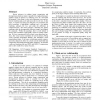Free Online Productivity Tools
i2Speak
i2Symbol
i2OCR
iTex2Img
iWeb2Print
iWeb2Shot
i2Type
iPdf2Split
iPdf2Merge
i2Bopomofo
i2Arabic
i2Style
i2Image
i2PDF
iLatex2Rtf
Sci2ools
SIGGRAPH
1995
ACM
1995
ACM
Polygon-assisted JPEG and MPEG compression of synthetic images
Recent advances in realtime image compression and decompression hardware make it possible for a high-performance graphics engine to operate as a rendering server in a networked environment. If the client is a low-end workstation or set-top box, then the rendering task can be split across the two devices. In this paper, we explore one strategy for doing this. For each frame, the server generates a high-quality rendering and a low-quality rendering, subtracts the two, and sends the difference in compressed form. The client generates a matching low quality rendering, adds the decompressed difference image, and displays the composite. Within this paradigm, there is wide latitude to choose what constitutes a high-quality versus low-quality rendering. We have experimented with textured versus untextured surfaces, fine versus coarse tessellation of curved surfaces, Phong versus Gouraud interpolated shading, and antialiased versus nonantialiased edges. In all cases, our polygon-assisted comp...
Computer Graphics | Low-quality Rendering | Rendering Task | SIGGRAPH 1995 | Versus Low-quality Rendering |
| Added | 26 Aug 2010 |
| Updated | 26 Aug 2010 |
| Type | Conference |
| Year | 1995 |
| Where | SIGGRAPH |
| Authors | Marc Levoy |
Comments (0)

